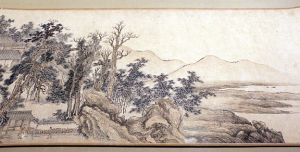Literati Painting
Sala Degli Alti Pini painted by Wang Hui (1632-1717) exemplifies the subjects of Chinese landscape painting: mountains, rivers, waterfalls, trees, rocks, temples, pavilions, houses, bridges, boats, wandering scholars, fishers – familiar motifs from a tradition now many centuries old.

China’s scholar class was unique, the product of an examination system designed to recruit the finest minds in the country for government service. Instituted during the Tang dynasty (618-907) and based on even earlier traditions, the civil service examinations were excruciatingly difficult, but for the tiny percentage who passed at the highest level, the rewards were great – prestige, position, power, and wealth. Steeped in philosophy, literature, and history, China’s scholars – often called wenren (literati) – shared a common outlook. Following Confucianism, they became officials to fulfill their obligation to the world; pulled by Daoism, they retreated from society in order to come to terms with nature and the universe – to create a garden, to write poetry, to paint.
During the Song Dynasty (960-1279) the examinations were expanded and regularized. More than half of all government positions come to be filled by scholars. In the subsequent Yuan and Ming periods, the traditions of literati painting (a style that reflected the taste of the educated class) further developed. When the Yuan period of foreign rule came to an end, the new Ming ruling house revived the court traditions of the Song. The Ming became the model for the rulers of Korea’s Joseon dynasty, under whose patronage these styles achieved a distinctive and austere beauty.[1]
- Marilyn Stokstad, Art History, vol. 2, 4th ed, (Upper Saddle River, NJ: Prentice Hall: 2011), 793. ↵

